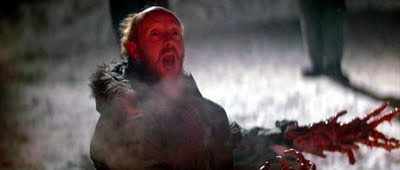 One of the books I’m reading and enjoying in preparation for an interview in the near future is Horror Noire: Blacks in American Horror Films from the 1890s to Present (Routledge, 2011), by Robin R. Means Coleman. As the title indicates, the book looks at how blacks are represented in horror films, and how their portrayal often reflects America’s long history of racism. While the book includes a wealth of examples, at one point in the volume Coleman considers John Carpenter’s 1982 film The Thing and the character Childs. She notes that this character represents a departure from Black roles in previous horror films, and is largely a positive one as a counterpoint to MacReady. But the assessment of Black representation in the film is not completely positive in her view.
One of the books I’m reading and enjoying in preparation for an interview in the near future is Horror Noire: Blacks in American Horror Films from the 1890s to Present (Routledge, 2011), by Robin R. Means Coleman. As the title indicates, the book looks at how blacks are represented in horror films, and how their portrayal often reflects America’s long history of racism. While the book includes a wealth of examples, at one point in the volume Coleman considers John Carpenter’s 1982 film The Thing and the character Childs. She notes that this character represents a departure from Black roles in previous horror films, and is largely a positive one as a counterpoint to MacReady. But the assessment of Black representation in the film is not completely positive in her view.
Looking at the final scene of the film where the Arctic camp has been blown to bits and only MacReady and Childs have survived, each skeptical of the other as to whether they are human or an alien, yet too tired and cold to do anything about it, Coleman considers this scene as a possible indicator of Black vs. White. Coleman quotes Edward Guerrero in a negative view of the final scene and what it allegedly says about race:
as the camera frames the survivors in medium close reverse shots of mutual suspicion, one can discern that the breath of the white man is heavily fogged in the Antarctic air, whereas the black man’s is not. The implication is subtle but clear. The Thing lives on and, interestingly enough, its carrier is yet another socially marginalized form, the black male.
I couldn’t disagree more with Guerrero’s reading of this scene. MacReady is framed with greater light from the surrounding fires of the camp than is Childs, and it is only natural that his breath would be more readily visible in the cold air. When this scene is compared with a previous one, the argument is weakened if not invalidated. Earlier in the film, after Bennings is taken over by The Thing he runs into the cold air and is surrounded by the members of the camp. As they confront him he runs and lets out a wail, and with it his breath is easily visible. Guerrero’s idea that we can discern the alien presence by noting which character’s breath is visible in the cold air breaks down with this contrast of one scene with another.
I believe that Coleman’s book is an important one as we grapple with the unfortunate depictions of racism in horror films, a topic which we will explore on this blog in greater depth in the future. But the case for racism in horror is weakened when forced readings see racism where none exists. Carpenter’s The Thing is to be commended for its inclusion of a strong Black character, bucking the trends of decades of prior horror films.
UPDATE 4/21/17
Collative Learning explored this topic and came to the same conclusion as mine previously discussed above. For that analysis see below. Collative Learning has a lot of great film analysis, including a substantial amount of interaction with genre films. Highly recommended.





There are no responses yet